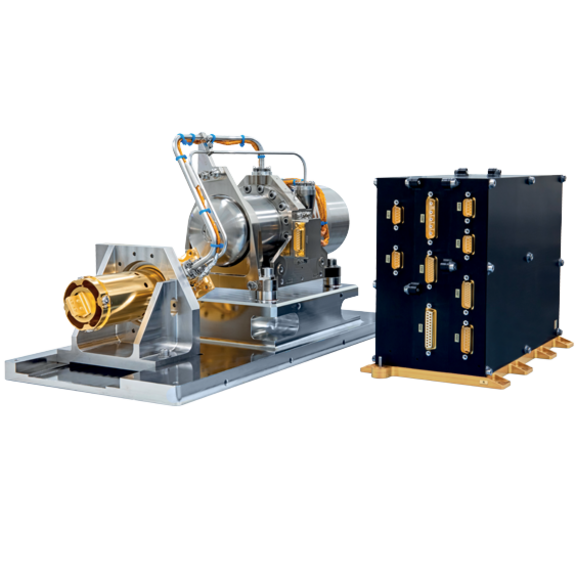These coolers have a temperature range of between 10K and 40K for the HiPTC (Heat intercepted Pulse Tube Cryocooler) and between 50K and 120K for the LPTC (Large Pulse Tube Cryocooler).
The Pulse Tube Cryocooler technology is based on a variation of the Stirling cycle where the displacer corresponds to a passively phase-shifted mass of gas. This cycle ensures the production of cold at a specific point of the system. The system consists of a balanced pressure oscillator and a coaxial pulse tube cold finger. The whole system is implemented by remote electronics.
Key benefits
- Easy to integrate ǀ The reduced vibration levels and the robustness of the cold finger make it easier to integrate the system close to the application that requires cooling
- Increased reliability and useful life ǀ This equipment has a completely passive cold finger and the compressor pistons are held on flexible bearings that eliminate all contact with the casings
- Reduced cost ǀ The simplicity of the cold finger, the lack of moving parts, and the lack of hydraulic actuators, reduce the complexity of the cooler drive electronics, thereby reducing the system impact and therefore costs.
- Vibration levels that are compatible with space applications ǀ The remarkably low levels of vibration (a few mN) mean that these machines are compatible with the very stringent specifications for photo detectors.
- Compliant with the highest standards ǀ ECSS ESA space standards
485mW @ 15K of cold power for HiPTC cryocoolers
3W @ 50K of cold power for LPTC cryocoolers
10 to 200 K at the cold end
over 20 years' useful life (storage + operation) without maintenance
Main technical characteristics
LPTC Large Pulse Tube Cooler
- Mass 7.3kg (without electric power)
- Cooling power: 3 W at 50K; 5.5 W at 70K
- Electric power: 160 W
HiPTC Heat Intercepted Pulse Tube Cooler
- Mass 22kg (without electric power)
- Cooling power: 400 mW at 15K; 5.2 W at 100K
- Electric power: 300 W
Download our brochure
-
Large pulse tube cryocooler
Download the document PDF (416.44 KB)
Solid references
- Air Liquide was selected by Thales Aliena Space to supply integrated solutions to cool Focal Plane Arrays around 50-60K in the frame of the Meteosat Third Generation (MTG) program.
- The Air Liquide LPTC cooler was also selected by Thales Aliena Space for one of its program.
- Airbus Defense and Space and the CNES selected the pulse tube cryocooler of Air Liquide advanced Technologies to handle the cooling of the new generation Infrared Atmospheric Sounding Interferometer (IASI-NG).
Contact Us
For more information, find on this page your key contacts and our contact form.
Space
Air Liquide has the ambition, the will and the expertise to engage in all the major new international challenges: electric propulsion, more competitive launch vehicles, the constellation of satellites, life in space, and more.
